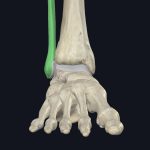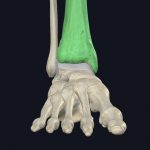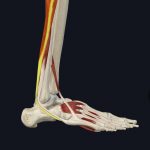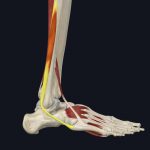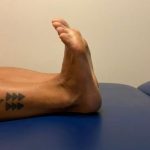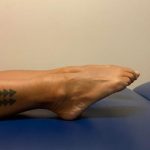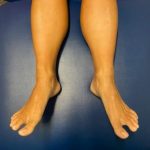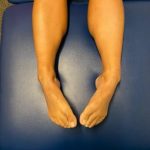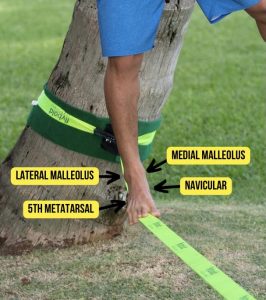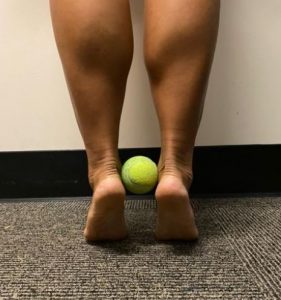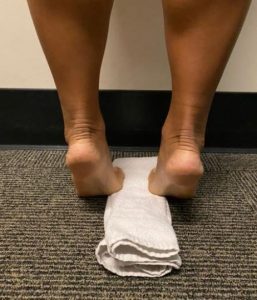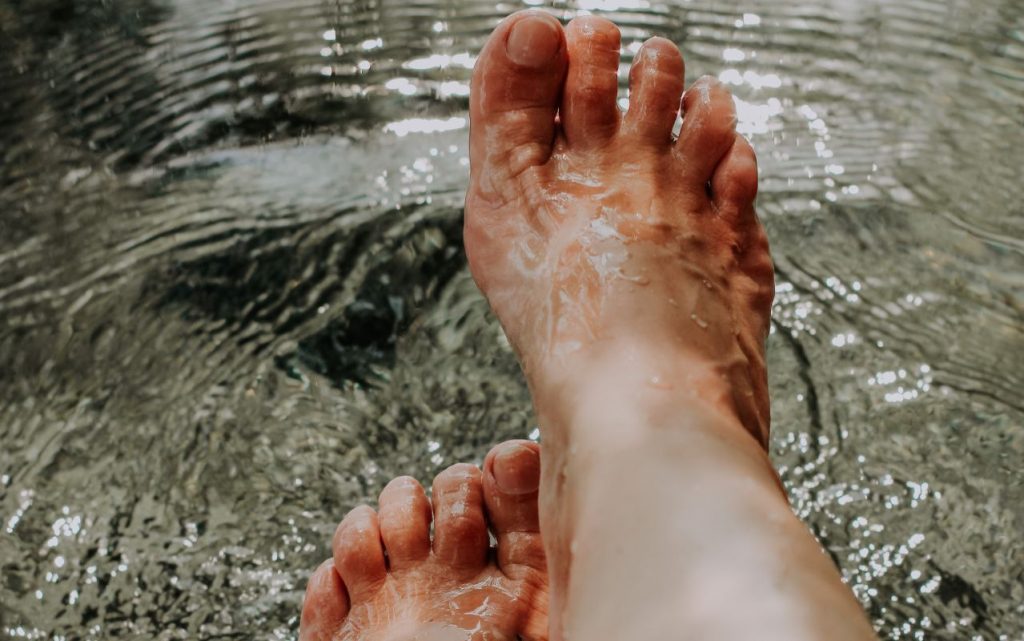
OUCH! Does the outside of your ankle or outside of your midfoot hurt when standing? Does your pain increase when you put weight through it, wear high heels, or stand on your tiptoes? Do symptoms worsen the longer you walk or run without relief, no matter how much you stretch out your foot?
The not-so-great news: You could be experiencing symptoms of peroneal (or fibularis) tendinopathy, which is the inflammation of a muscle located on the outside of your foot.
The great news: Physical therapy may help bring you relief and guide you back to the activities you love!
Note: If you remember your pain starting after twisting or rolling your ankle, check out this blog post on the different types of ankle sprains, how to manage these injuries, and the rehabilitation process. Here is a bonus blog for hikers who are curious about how to protect against their ankle sprains.
What Are the Peroneal Muscles?
First, let’s discuss your lower leg and ankle anatomy. Your lower leg is composed of two main bones: the tibia and the fibula.
The tibia is the larger shin bone located between your knee and ankle. The fibula is a smaller, thinner bone situated next to your tibia on the outside (or lateral aspect) of your lower leg. These bones help form the top of the ankle joint.
- Fibula (highlighted)
- Tibia (highlighted)
Images courtesy of Complete Anatomy
There are two peroneal muscles that are attached to the fibula bone: the peroneus longus and peroneus brevis. The peroneus longus attaches from the top half of the fibula, crosses behind the outside of your ankle bone, and attaches to the inside arch of your foot. It’s a long tendon, hence the “longus” in its name.
The peroneus brevis attaches from the bottom two-thirds of the fibula, crosses behind the side of your ankle joint, and attaches to the outside of your midfoot. The word “brevis” means it is brief, as its tendon is not as long as the peroneus longus muscle.
- Fibularis Longus (highlighted)
- Fibularis Brevis (highlighted)
Images courtesy of Complete Anatomy
What Are Their Actions?
There are four primary ankle movements—some activate the peroneals, and others stretch them.
- Dorsiflexion
- Plantarflexion
- Eversion
- Inversion
The peroneal muscles help move your ankle outward and point downward (eversion and plantarflexion). They also help keep your ankle in a neutral position just before you take a step and actively stabilize the outside of your ankle bones while bearing weight on your leg as you walk.
The peroneal muscles are stretched when you move your ankle inward and upward (inversion and dorsiflexion), similar to the position that could sprain your ankle.
Don’t Forget the Ligaments
Your peroneal muscles aren’t the only structures that protect the ankle. You have many ligaments around your ankle joint that connect your ankle bones together to support the foot and ankle structure. Ligaments also provide stability while placing weight through your ankle, especially when walking on uneven surfaces, changing direction, or standing on tiptoes.
These structures provide passive stability because they don’t contract or stretch the way muscles can. They’re like ropes that tighten or slacken with movement. An injury to a ligament is an ankle sprain.
Together, your peroneal muscles work with your ligaments to protect the ankle. If one of these structures is weak or injured, your ankles would lack lateral stability. And if you have neither, you’d probably be rolling them with each step. And we wouldn’t want that!
What is Tendinopathy?
Let’s unpack this. The prefix Tendino- refers to a tendon which is the structure that attaches a muscle belly to a bone. -Pathy is the general suffix which means there is a change to a structure whether it be irritation, scarring, or a potential tear. Together, tendinopathy means there has been a change to a tendon. Peroneal tendinopathy means there is a change in the tendons of the peroneal muscles.
Symptoms and Rehab Potential of Peroneal Tendinopathies
There are multiple structures that could cause ankle pain. It’s important to differentiate between diagnoses since this will affect the rehab process and prognosis. For example, a group of researchers found that acute peroneal tendon dislocations are accidentally diagnosed as lateral ankle ligament sprains in up to 40% of cases. (1)
- You had a recent increase in physical activity and are now experiencing the same level of ankle pain lasting more than 1 week.
- You have pain or tenderness when pressing behind the outside ankle bone or the outside of your midfoot.
- Stretching your foot into the downward and inward position (stretching the muscle) is painful or increases the soreness.
- The pain on the outside of the ankle bone or outside of the midfoot worsens when standing on tiptoes, while walking in heels, or with increased walking or running time/distance.
If any or all of these apply to you, you may have a peroneal tendon pathology and could benefit from closer evaluation by a physical therapist.
When Your Primary Care Physician (PCP) Would Consider Imaging
Sometimes, fractures present like tendinopathies. We catch potential misdiagnoses using a screening tool called the “Ottawa Ankle Rules,” which can help rule out a fracture. The rules are as follows:
- Tenderness to palpation along the ankle bones (landmarks highlighted in image below).
- Unable to bear weight through your ankle >24 hours after an injury.
- Dangerous mechanism of injury, like high-velocity twisting, landing and twisting, car accidents, machinery accidents, etc.
- Ottowa Ankle Rule Landmarks
If any or all of these apply to you, consider contacting your PCP for further imaging to rule out a potential fracture.
Peroneal Tendinopathy Treatment
The first priority is to reduce painful symptoms. The most effective way to do this is by removing painful activities, but that doesn’t mean removing all activities. Talk with your physical therapist to determine which activities you should avoid, and which ones are okay based on your symptoms.
Generally, when it comes to tendinopathies, immobilization is a temporary treatment along with other conservative treatments like nonsteroidal anti-inflammatory drugs, heat and ice, bracing, and physical therapy. (2, 3)
As pain improves, treatment focuses on incrementally increasing your tolerated activity. A physical therapist will guide you in tailored exercises, slowly building your muscles’ tolerance to activation and stretch in sitting or standing positions. Once you can tolerate walking on level ground without pain, you can slowly return to higher-level activities like walking on the beach or running.
One of the most important aspects of regaining full function while preventing future re-injury is regaining foot and ankle coordination through balance. You can improve balance by standing on uneven surfaces or standing on one leg to start. But if you want bulletproof ankles, you must train balance in dynamic situations that involve jumping, cutting, or even walking on unsteady ground.
Your personal goals help dictate the goals we set for you in the clinic. We help patients return to everyday activities like going up and down stairs, or we help them return to sports like tennis, martial arts, surfing, or soccer. Tell us your goals at a JACO evaluation!
Preventing Peroneal Tendinopathy
The ankle is comprised of bones, muscles, and ligaments that control movement and provide stability. Remember that they all work together to protect the ankle during weight-bearing tasks like walking and running. If one or more of these structures is injured or painful, other structures are forced to help take over, increasing the possibility of developing pain as well. This is why it’s important to keep your ankles strong and healthy.
You may have heard the phrase “Movement is Medicine” for healthier living. It’s true! To prevent injuries, you shouldn’t avoid movement—you should engage in it, incrementally. Here are a few tips to prevent peroneal tendinopathy as you increase activity or start something new:
- Slowly increase your physical activity if you are trying a new activity or sport. Try starting with 20-30 min of the activity first and slowly increasing by intervals of 15-20 min as tolerated so your ankles get used to the increased demand on them.
- Stretch your ankles after physical activity just like how you would after lifting weights to bring relief to your ankle muscles following an increased load/demand on those muscles.
- Strengthen the muscles on the bottom (or arch) of your feet by engaging in balance activities. The bottom of your foot has small, deep muscles that help create force and distribute the load as you walk or run, which can help offload other muscles around your foot and ankle.
Try These Peroneal Tendinopathy Exercises
We covered the primary movements of the ankle muscles and the importance of ankle alignment so all these muscles can work together as efficiently as possible. A low-level exercise very specific to the ankles is a heel raise, which can be used to prevent injury or rehabilitate your peroneal tendinopathy.
Try one of these exercises out! But if you notice pain, come to physical therapy and receive more tailored suggestions.
Heel Raises with a Tennis Ball
Perform heel raises with a tennis ball or rolled-up socks (anything soft) between your heels and squeeze through it as you raise your heels up and down. This will assist in the alignment of your ankle through the movement, reducing stress on the outside of your ankle where your peroneal muscles live.
Perform 5 or 10 repetitions first to see how it feels. Then, if it feels good, perform 2 sets of 8-10 repetitions.
Heel Raises with Towel Cue
Another variation involves performing your heel raises with a towel under the base of your big toe. Think about pressing down into it as you raise your heels off the ground, maintaining neutral ankle alignment.
Perform 5 or 10 repetitions first to see how it feels. Then, if it feels good, perform 2 sets of 8-10 repetitions.
Note: If these are painful, each of these can be performed through a smaller, pain-free range or even in a seated position
Next Steps for Recovery
Sign up on JACO Rehab to set up an initial evaluation with one of our highly trained physical therapists. Choose between our four locations on Oahu: Honolulu, Waikele, Mililani, and Kapolei.
We offer early morning and late evening appointments, all of which are one-on-one sessions to best fit your busy schedule. Don’t wait—reach out!
Written by Susana Gutierrez, SPT, MS
Medically Reviewed by Kristen Shimabukuro, DPT and Nicole Hernandez, DPT
Resources
1. Dombek MF, Lamm BM, Saltrick K, Mendicino RW, Catanzariti AR. Peroneal tendon tears: a retrospective review. J Foot Ankle Surg. 2003;42(5):250-258. doi:10.1016/s1067-2516(03)00314-4
2. Heckman DS, Gluck GS, Parekh SG. Tendon disorders of the foot and ankle, part 1: peroneal tendon disorders. Am J Sports Med. 2009;37(3):614-625. doi:10.1177/0363546508331206
3. Lugo-Pico JG, Kaiser JT, Sanchez RA, Aiyer AA. Peroneal Tendinosis and Subluxation. Clin Sports Med. 2020;39(4):845-858. doi:10.1016/j.csm.2020.07.005
